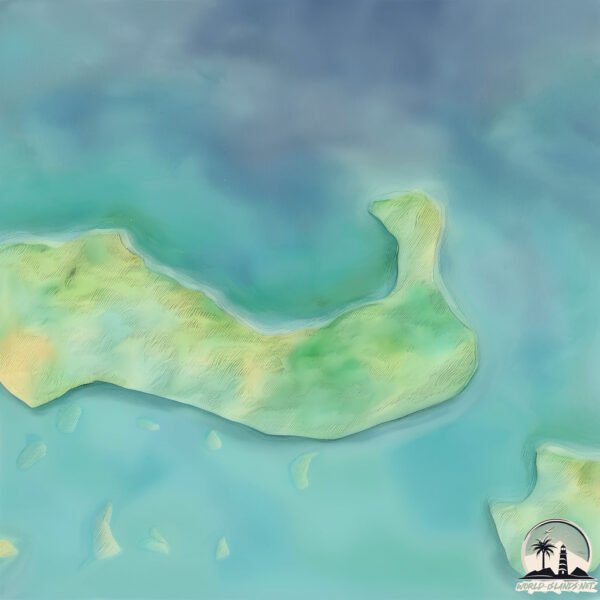Cayo Bahía de Cádiz

Welcome to Cayo Bahía de Cádiz, a Tropical island in the North Atlantic Ocean, part of the majestic Atlantic Ocean. This guide offers a comprehensive overview of what makes Cayo Bahía de Cádiz unique – from its geography and climate to its population, infrastructure, and beyond. Dive into the details:
- Geography and Size: Explore the island’s size and location.
- Climate and Weather: Weather patterns and temperature.
- Topography and Nature: Uncover the natural wonders of the island.
- Infrastructure and Travelling: Insights on reaching, staying, and making the most of your visit.
- News and Headlines: Latest News.
Geography and size of Cayo Bahía de Cádiz
Size: 11.5 km²
Coastline: 35.8 km
Ocean: Atlantic Ocean
Sea: North Atlantic Ocean
Continent: North America
Cayo Bahía de Cádiz is a Medium Island spanning 12 km² with a coastline of 36 km.
Archipel: Greater Antilles – A major island group in the Caribbean, including Cuba, Jamaica, Hispaniola, and Puerto Rico, known for their rich history and diverse cultures.
Tectonic Plate: North America – Covers North America and parts of the Atlantic and Arctic Oceans, characterized by diverse geological features and varying levels of seismic activity.
The geographic heart of the island is pinpointed at these coordinates:
Latitude: 23.17912493 / Longitude: -80.49318746
Climate and weather of Cayo Bahía de Cádiz
Climate Zone: Tropical
Climate Details: Tropical Savanna, Wet
Temperature: Hot
Climate Characteristics: Defined by distinct wet and dry seasons with high temperatures year-round. Pronounced rainfall occurs during the wet season, while the dry season is marked by drought.
Topography and nature of Cayo Bahía de Cádiz
Timezone: UTC-05:00
Timezone places: America/New_York
Max. Elevation: 6 m
Mean Elevation: 4 m
Vegetation: Mangrove Forest
Tree Coverage: 81%
The mean elevation is 4 m. The highest elevation on the island reaches approximately 6 meters above sea level. The island is characterized by Plains: Flat, low-lying lands characterized by a maximum elevation of up to 200 meters. On islands, plains are typically coastal lowlands or central flat areas.
Dominating Vegetation: Mangrove Forest
Found in coastal areas and river deltas, these unique wetland ecosystems are adapted to saline conditions and are crucial for coastal protection and biodiversity. Cayo Bahía de Cádiz has a tree cover of 81 %.
Vegetation: 8 vegetation zones – Very Highly Diverse Island
Islands in this range are ecological powerhouses, showcasing a wide array of vegetation zones. Each zone, from lush rainforests to arid scrublands, coastal mangroves to mountainous regions, contributes to a complex and interdependent ecosystem. These islands are often hotspots of biodiversity, supporting numerous species and intricate ecological processes.
Infrastructure and Travelling to Cayo Bahía de Cádiz
Does the island have a public airport? no.
There is no public and scheduled airport on Cayo Bahía de Cádiz. The nearest airport is Abel Santamaria Airport, located 95 km away.
Does the island have a major port? no.
There are no major ports on Cayo Bahía de Cádiz. The closest major port is ISABELA DE SAGUA, approximately 58 km away.
The mean population of Cayo Bahía de Cádiz is 21 per km². Cayo Bahía de Cádiz is Gently Populated. The island belongs to Cuba.
Continuing your journey, Cayo Empalizada de Sotavento is the next notable island, situated merely km away.
Cuba is classified as Emerging region: G20: Group of Twenty – Major economies comprising both developed and emerging countries, representing the world’s largest economies. The level of income is Upper middle income.
News – Latest Updates and Headlines from Cayo Bahía de Cádiz
Stay informed with the most recent news and important headlines from Cayo Bahía de Cádiz. Here’s a roundup of the latest developments.
Please note: The data used here has been primarily extracted from satellite readings. Deviations from exact values may occur, particularly regarding the height of elevations and population density. Land area and coastline measurements refer to average values at mean high tide.
